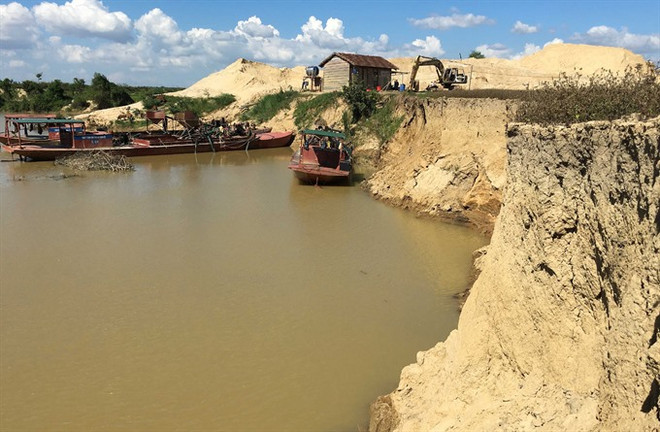 Serious bank erosion on the Krong Pak River in Dak Lak province near the site of the Doan Ket sand mining company (Photo: VNA)
Serious bank erosion on the Krong Pak River in Dak Lak province near the site of the Doan Ket sand mining company (Photo: VNA)Hanoi (VNA) - Poor planning and management of sand mining has led to astunning but unsurprising warning: Vietnam is very likely to run out of sand inless than 15 years.
A report by the Department of Construction Materials (DoCM) of the Ministry ofConstruction says the demand for sand in 2015 stood at 92 million cubic metres,and will surge by some 40 percent to about 130 million in 2020.
The driving force behind the increase is the construction frenzy across Vietnam,a developing nation pouring more and more cash into infrastructure investment,especially in cities.
But legally licensed sand mining can only meet some 60 to 65 percent of theneed of big cities, according to the DoCM.
The gap, consequently, was filled with the sand exploited illegally fromseveral rivers under the eyes of local authorities for years. They refused totighten their grip on the sand mining until a recent crackdown ordered by thecentral government following an expose by Tuoi tre (Youth) newspaper aboutillegal sand mined in Vietnam was shipped to Singapore.
The crackdown on illegal sand mining, plus a suspension of activity in legalmines for a thorough review of the industry, has further strained sand suppliesto the market, resulting in prices immediately shooting over the roof in thefollowing months and showing no signs of stopping.
According to Tuoi tre, sand prices in the Cuu Long (Mekong) Delta nearlydoubled compared to two months ago. Yellow sand, for example, is sold in Can Thocity at 100,000 VND (4.4 USD) a cubic metre instead of just 65,000 VND back inMarch.
A construction material seller in Vinh Long province, meanwhile, said that theprice of the particular sand used for leveling ground increased by about 40 percentin just one day, from 80,000 VND on May 2 to 115,000 VND a cubic metre thefollowing day. He told Tuoi tre that the sand supply was becoming “very scarce”and everything was sold out despite.
HCM City – the economic hub of the south – saw a rocketing three-fold pricehike. The yellow sand used for mixing mortar is sold at more or less 600,000 VNDa cubic metre, compared to just 180,000 VND a month ago.
The Ministry of Natural Resources and Environment has also voiced concerns overthe sand resource, warning that there was a real risk of sand running out forconstruction and alternatives must be seriously considered.
One option, according to the natural resources ministry, was to use artificialsand created by crushing rocks. The material was in fact used in someconstruction, like the Son La and Lai Chau hydropower plants.
Hoa Binh Construction and Real Estate Corporation’s Supplies Division Head HuynhNhan Quang suggested looking for factory-produced mortar instead of followingthe traditional way of mixing sand and cement. “The supply of ready mixedmortar in Vietnam is limited, though, for the demand of the constructionmarket,” Quang said.
Given the almost total reliance on sand until now, Ha Tien Cement Company, thebiggest mortar producer in Vietnam, even decided last year to suspend drymortar manufacturing, feeling there was insufficient demand, he said.
“We hope that (mortar) manufacturers soon reevaluate the market to develop sandalternative products in order to meet the upcoming wave of market demand,” hesaid.-VNA





























